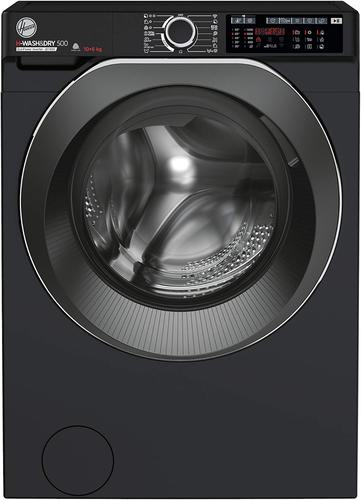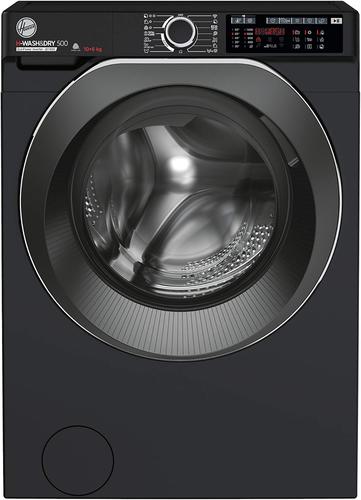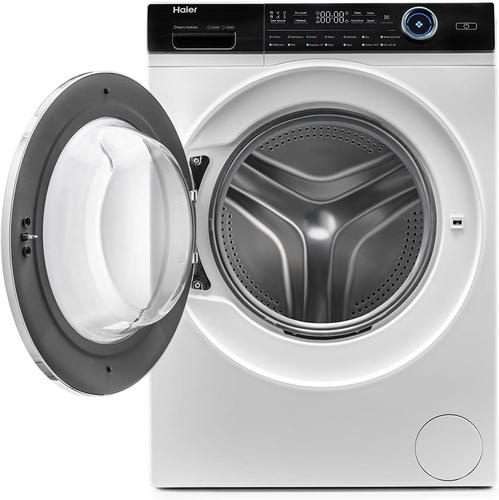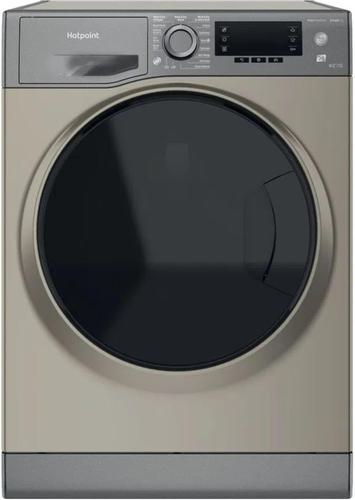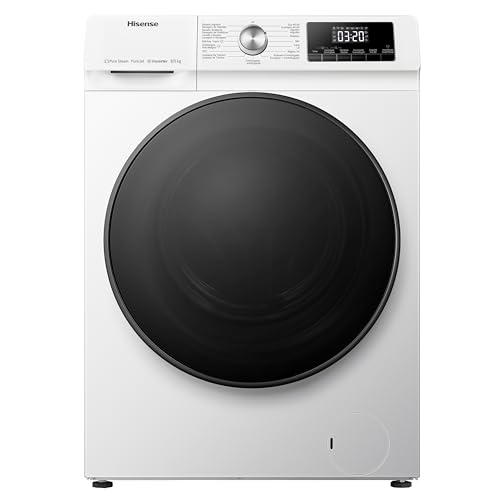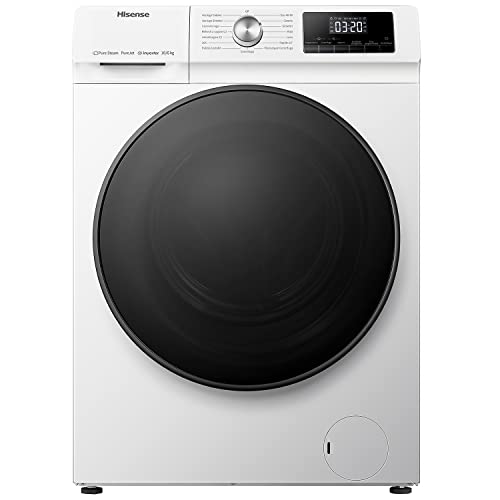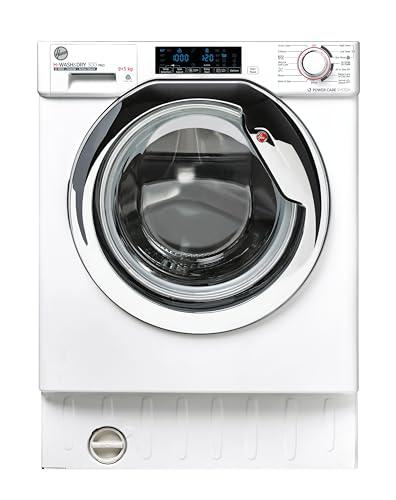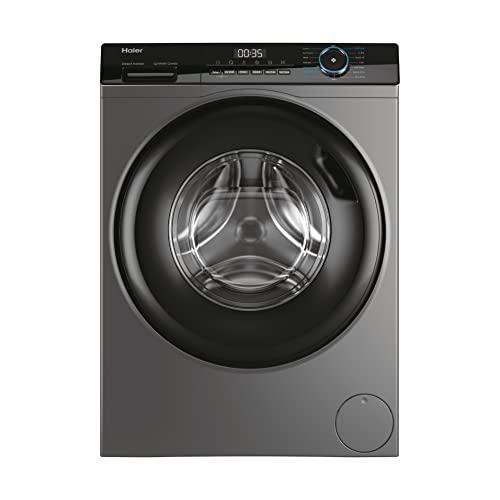What does it mean when a washer-dryer belongs to energy class A?
When a washer-dryer belongs to energy class A, it means the washer-dryer has very high energy efficiency during the washing phase. It consumes less electricity than other washer-dryers with lower washing energy classes.
Every washer-dryer has an energy label that shows two energy classes:
- one for washing energy efficiency
- one for combined energy efficiency (washing + drying cycle)
Washing energy efficiency class A means the appliance performs very well during washing and uses less electricity compared to other machines. These models are easy to recognize by the “A” mark on the label.
You can find the distribution of energy classes across all tumble dryers on the market as follows:
- A class: 48%
- B class: 19%
- C class: 18%
- D class: 12%
- E class: 3%
- F class: <1%
- G class: <1%
Combined energy efficiency classes on washer-dryers appear on the market as follows:
- A class: <1%
- B class: <1%
- C class: <1%
- D class: ~41%
- E class: ~49%
- F class: ~4%
You can see that washer-dryers with A to C combined classes are extremely rare. These are mostly heat pump washer-dryers, which are not common. The best washer-dryers usually fall into combined class D.
Because very few models have A combined energy class, in this article we only focus on washer-dryers with washing energy efficiency class A, no matter their combined class.
The distribution of washing energy efficiency classes across washer-dryers is illustrated in the chart below.
[pie-chart-28315828093821883]
How are energy classes calculated?
Washer-dryer energy classes are calculated based on standardized EU regulations. You get two separate energy classes: one for wash-only mode (called Washing energy efficiency class), and one for wash & dry mode (called Combined energy efficiency class). The classification depends on the weighted energy consumption per 100 cycles, measured in kilowatt-hours (kWh).
The process works as follows:
- Measuring Energy Consumption
- Wash-only mode: Energy consumption is measured for the Eco 40-60 cycle. Tests run at full load, half load, and quarter load. The results are used to calculate a weighted average per 100 cycles.
- Wash & dry mode: Energy consumption is measured for a full washing and drying cycle. Tests run at full load and half load. The results are used to calculate a weighted average per 100 cycles.
- Defining the Energy Class Thresholds
Energy class depends on how much energy the washer-dryer uses per 100 cycles. The lower the number, the better the class. The EU defines the ranges as follows:
Energy Class Wash-only (kWh/100 cycles)
- A: ≤ 51
- B: 51 - 55
- C: 55 - 60
- D: 60 - 65
- E: 65 - 75
- F: 75 - 85
- G: > 85
Energy Class Wash & dry (kWh/100 cycles)
- A: ≤ 215
- B: 215 - 250
- C: 250 - 285
- D: 285 - 320
- E: 320 - 360
- F: 360 - 400
- G: > 400
- Additional Considerations
- Water consumption (liters per cycle): measured but does not affect energy class
- Drying efficiency and spin-drying performance: evaluated separately
- Standard room temperature during testing: 23°C
- Wash & dry mode usually uses more energy than wash-only mode because drying consumes more electricity
Some washer-dryers have a better energy rating in wash-only mode than in combined mode. You should always check both values before you choose one.
The chart below shows the distribution of drying energy efficiency classes across washer-dryers.
[pie-chart-28992828772021680]
The best washer-dryers with washing energy class A are as follows.
- Samsung WD90DG6B85BEU1 Series 6 (Overall score: 8.67 points; Capacity: 9 kg)
- Hoover H-WASH&DRY 500 HD4106ABMCB (Overall score: 8.23 points; Capacity: 10 kg)
- Hoover H-WASH&DRY 500 HD496AMBCB (Overall score: 8.23 points; Capacity: 9 kg)
Note: Products currently available are listed first.
How many kWh does a washer-dryer with energy class A consume?
A washer-dryer with energy class A consumes from 42 to 56 kWh per 100 washing cycles, with an average of 49 kWh (less than the market average of 55 kWh), and from 190 to 380 kWh per 100 combined cycles, with an average of 308 kWh (a bit lower than the market average of 318 kWh).
You can expect better efficiency with class A models during washing, but energy use increases significantly during combined wash and dry cycles. If you mostly run washing-only programs, you will stay close to the lower end of energy consumption. If you often use full wash and dry cycles, your usage will move toward the higher range.
The following chart illustrates the distribution of energy consumption per 100 combined cycles for A class washer-dryers.
[vertical-chart-55322856849132551]
Which are the most energy-efficient brands of washer-dryers?
The washer-dryer brands with the lowest combined energy consumption are as follows.
- Beko (Average consumption: 264 kWh/100 cycles kWh per 100 combined cycles)
- AEG (Average consumption: 291 kWh/100 cycles kWh per 100 combined cycles)
- Candy (Average consumption: 308 kWh/100 cycles kWh per 100 combined cycles)
The chart below ranks washer-dryer brands based on their average energy consumption per 100 combined cycles.
[horizontal-chart-78366383307338354]
Are washer-dryers with energy class A better than those with other energy classes?
Washer-dryers with energy class A are on average better than washer-dryers with lower energy classes.
Washer-dryers of washing energy class A receive an average overall score of 7.6 points, higher than the market average of 7.3 points. You also see a high average user rating for class A washer-dryers: 7.9 points.
The average overall score of washer-dryers with lower energy classes is as follows:
- Average overall score of A class washer-dryers: 7.6 points
- Average overall score of B class washer-dryers: 7.2 points
- Average overall score of C class washer-dryers: 7.3 points
- Average overall score of D class washer-dryers: 7 points
- Average overall score of E class washer-dryers: 6.3 points
Washer-dryers in class A perform above the market average across both technical tests and user satisfaction.
Are washer-dryers with energy efficiency class A more expensive?
Washer-dryers with energy efficiency class A usually cost more. On average, a class A washer-dryer costs about £570, while the average price for a standard dryer on the market is £550, so you pay only £20 more to reduce energy use and save money over time.
Models with class B and C both average £550, and class D models cost less at £430. Class A washer-dryers usually have more advanced technology such as inverter motors or laundry detection systems, which reduce energy consumption. These features raise the price, but you can still find a few lower-end washer-dryers with energy class A and low energy use.
The price distribution for A class washer-dryers is presented in the following chart.
[vertical-chart-24374724938121622]
Which type of washer-dryer is most energy efficient?
The most energy efficient washer-dryers are heat pump washer-dryers.
Heat pump washer-dryers usually have a combined energy class between A and D, while condenser washer-dryers have energy classes between D and F. Heat pump models consume an average of 275 kWh per 100 combined cycles. Condenser washer-dryers consume more, with an average of 322 kWh per 100 combined cycles.
Are washer-dryers with energy class A quieter than other dryers?
Washer-dryers with energy class A are not quieter than other dryers. They are generally similar to the market average in terms of noisiness across all phases.
Noise levels during different phases are as follows:
- Spin noise level: in class A washer-dryers range from 69 to 82 dB, with the average being 75 dB (same as market average)
- Washing noise level: in class A washer-dryers range from 50 to 62 dB, with the average being 52 dB (a bit lower than market average of 54 dB)
- Drying noise level: in class A washer-dryers usually range from 51 to 66 dB, with the average being 58 dB (similar to market average of 59 dB)
Noise emission class in class A washer-dryers usually range from class A to D:
- Class A: is the most common (37%)
- Class B: (37%)
- Class C: (24%)
- Class D: (1%)
What influences the energy consumption of a washer-dryer?
The energy consumption of a washer-dryer depends on several technical factors. These influence how much electricity and water the appliance uses during combined wash and dry cycles. The factors are as follows:
- Drying technology (275 kWh per 100 combined cycles on average vs. 322 kWh per 100 combined cycles on average): Heat pump technology uses less energy than condenser drying because it recycles heat instead of generating it through heating elements.
- Sensor technology: Advanced models use sensors that adjust water and energy use based on the load weight and fabric type, so they reduce waste.
- Washing and drying cycles: Longer cycles, higher temperatures, and intensive drying phases increase consumption because the appliance runs for a longer time and uses more heat.
- Load size: A full load optimizes energy efficiency. A half-empty drum still uses nearly the same amount of energy as a full one without using full capacity.
- Spin speed: Higher spin speeds extract more water during the final wash cycle, which reduces drying time and energy consumption.
- Water usage: Some condenser models use water during drying. This increases both water and energy consumption.
- Temperature settings: Lower wash temperatures like 30°C instead of 60°C cut energy use significantly.
- Eco Modes: Many modern models include Eco modes that optimize water and electricity use, but these cycles usually take longer to finish.
- Maintenance: You need to clean lint filters, condenser units, and detergent dispensers regularly. This keeps the appliance working efficiently and prevents high energy use.
Which features have the greatest influence on the energy consumption of a washer-dryer?
The features that have the greatest influence on the energy consumption of a washer-dryer are as follows.
- Inverter motor (in ~99% of A class washer-dryers, vs 89% of washer-dryers in general): It adjusts the motor speed depending on the load and program, so it reduces energy waste and improves efficiency, especially during low or medium load cycles.
- Laundry detection system (in ~93% of A class washer-dryers): It detects the weight and type of laundry, so the machine adapts water and energy use accordingly and avoids overconsumption.
- Automatic drying (in ~94% of A class washer-dryers): It measures humidity in the drum and stops the drying process when laundry reaches the selected dryness level, so it avoids unnecessary drying time and energy use.
- Pre-mix technology (in ~38% of A class washer-dryers): It mixes water and detergent before injecting them into the drum, so detergent activates faster and works at lower temperatures, which reduces energy use in washing.
- Selectable drying level (in ~91% of A class washer-dryers): You can choose a lower drying level, so the machine uses less energy when full drying is not needed.
- Delay start option (in all of A class washer-dryers): You can schedule washing and drying cycles during off-peak electricity hours, which reduces energy cost even if consumption stays the same.
- Eco function (in ~23% of A class washer-dryers, vs 8% of washer-dryers in general): It reduces temperature and water flow during the cycle and increases drum movement duration, so the machine reduces energy use while maintaining wash performance.
- Eco indicator (in ~15% of A class washer-dryers): It shows estimated energy consumption before starting a cycle, so you can choose the most efficient option.
- Automatic load balancing during spin (in ~46% of A class washer-dryers): It adjusts drum spin to prevent imbalance during high-speed spin, which improves energy use and protects the machine over time.
- Foam control system (in ~75% of A class washer-dryers, vs 62% of washer-dryers in general): It detects and reduces excess foam during rinsing, so the machine avoids extra rinse cycles and energy waste.
- Wi-Fi (in ~43% of A class washer-dryers, vs in 31% of all washer-dryers in general) – While not directly energy-efficient, Wi-Fi connectivity can add smart functions which optimize energy use, such as scheduling cycles during off-peak hours or tracking energy consumption history.
- AI (~22% of washer-dryers with energy class A, vs in 17% in washer-dryers in general) – It analyses fabric type, load size, and dirt level, then automatically selects optimal washing and drying settings, which improves energy efficiency by avoiding overuse of heat, water, or spin.
The more of those features washer-dryers have, more energy efficient they usually are.
While not directly influencing energy consumption, the following features are also pretty common in washer-dryers with energy class A.
- Smart diagnosis: in 54% of A energy class washer-dryers
- Memory function: in 48% of A energy class washer-dryers
Consider which features you think you need and choose the right model based on that. You can filter the washer-dryers based on the specific features on our website.
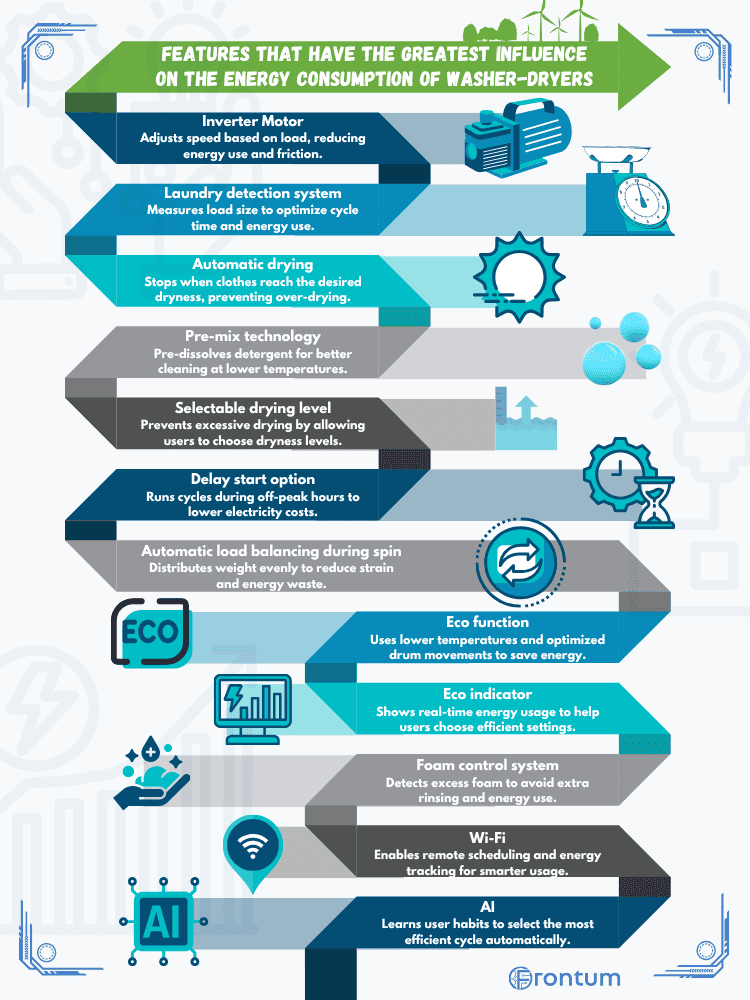
Are washer-dryers with multiple wash programs more energy efficient?
Washer-dryers with multiple wash programs are not automatically more energy efficient. The number of programs does not directly affect efficiency. However, more drying options can help you choose the most suitable one for each load, so you can reduce energy use.
When you select specific programs like Eco 40-60, which most models include, or use modes such as Power Save, you lower energy consumption. LG models with the Eco Hybrid function reduce energy use by up to £20. These programs balance time and electricity use better than standard cycles.
What are the most common programs in energy class A washer-dryers?
Most common programs in energy class A washer-dryers include all basic cycles such as Cottons, Synthetics, Mix, etc., and many of them also include specialized programs.
You usually get 10 to 23 washing programs (average is 13), which is similar to washer-dryers in other energy classes.
The most common specialized programs are as follows:
- Wool: ~93% of A class washer-dryers include this program
- Refresh cycle: ~84%
- Gentle cycle: ~82%
- Hygiene cycle: ~53%
- Allergy cycle: ~53%
- Colors cycle: ~38%
- Outdoor/Sport cycle: ~31%
- Duvet cycle: ~14%
- Baby-care cycle: ~12%
- Shirt cycle: ~10%
- Jeans cycle: ~7%
Most A class washer-dryers have the same variety of basic and specialized programs as other classes, but they reach higher energy efficiency.
Are washer-dryers with bigger capacities more energy efficient?
Washer-dryers with bigger capacities tend to be more energy efficient in terms of kWh per kilogram.
55% of washer-dryers with 9 kg capacity have an energy class A rating. For 8 kg washer-dryers, it's 46%. Only 7% of washer-dryers with 7 kg capacity have an A rating. 9 kg washer-dryers are the most common ones with A rating (33%), followed by 8 kg models (31%).
There is no strong link between capacity and total energy use. You might expect bigger washer-dryers to use more energy, but the data does not support that.
The average energy consumption of different washer-dryer capacities is as follows:
- 7 kg: £60 per 100 washing cycles
- 8 kg: £50 per 100 washing cycles
- 9 kg: £40 per 100 washing cycles
- 10 kg: £40 per 100 washing cycles
9 and 10 kg washer-dryers use the least energy on average. Energy use drops up to 9 kg and then rises again. Washer-dryers with larger capacities often use advanced technologies like better load sensing and more efficient motors, which help reduce energy consumption. 8 and 9 kg washer-dryers strike a balance—they use modern features but do not handle very large loads that need more energy.
If you want to reduce energy use, wash and dry full or near-full loads. Overloading reduces drying performance and may need extra cycles. Underloading wastes energy.
Are there any slim dryers with energy class A?
Yes, there are slim dryers with energy class A. Slim washer-dryers usually range in depth from 47 to 69 cm, so some of them fall into energy class A and still keep a compact design. You can find energy class A models within this depth range, which means they fit well in smaller spaces and still meet the highest energy efficiency rating.



